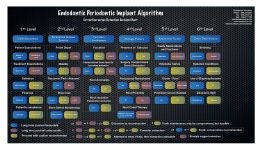
The recent DrBicuspid.com article, "Dentists balk at referring implant patients to endodontists," focused on two studies from the Journal of Endodontics that raise some questions about the role of endodontists in the dental food chain.
One reported that 94% of general practitioners surveyed had positive perceptions of endodontists, but only referred 46% of patients who required root canal treatment to endodontists. In the other, a survey sent to 1,500 randomly selected practicing general dentists in the U.S. found that 66% were opposed to endodontists placing dental implants, and as many as 73% indicated that they would not refer patients to an endodontist for implant placement.
The design of the second study focuses on respondents' perception of skill (theirs versus the endodontists) and personal bias in the subtext. The latter is a very dangerous thing to analyze. The scope of the question needs to be expanded further to address who is driving implant placement and why endodontists have seen this as a right of passage in their service mix.
The question that should be posed first and foremost is why this paradigm shift is occurring. The answer is multivariate, but in the scope of this article, I'd like to address what I consider the primary factor: Market is driving science, and bottom lines are the sine qua non of an industry that should be evidence-based, not eminence-based.
The history of implant placement was based on territoriality from the outset. Periodontists were refused entry to the club early on; prosthodontists were told to mind their business as well. The science of implantology went through massive iterations over the years, resulting in the ability of many practitioners to replace a tooth in the aesthetic zone with almost preternatural skill.
Likewise, innovations in the endodontic armamentarium and the technical aspect of the discipline have also undergone an evolution over the past two decades. Unfortunately, guru-driven, fiduciary-aligned education became the modus operandi of many companies. Most of the endodontic marketing campaigns could be subliminally read as "simplified" -- that is, "anyone can do it." That may be true in a percentage of cases, but the enormous preponderance of endodontic treatment by specialists has shifted to retreatment of primary therapy. Factor in the decimation of residual tooth structure by poorly designed post systems and sizes, and you have an invitation to disaster: implant replacement.

Endodontists should always have been party to the critical thinking and comprehensive reasoning essential to the complexity of treatment planning. Bridging the gap between the specialties should not have waited until 2011 to be the concept behind the major endodontic meeting in North America. The endodontic periodontic implant algorithm has been waiting in the wings for years; unfortunately, none of the major endodontic houses worldwide nor the associations or most of the postdoctoral programs saw the writing on the wall.
The linking of endodontics companies with implant companies is becoming "de rigeur," but they have failed to bridge the gap between their product silos. As a result, endodontics as a specialty is being diminished. When a pendulum swings, its arc invariably reaches the full swing based on its dynamics unless there is sufficient frictional resistance to adjust its path. That friction was incumbent on the associations, the postdoctoral directors, and the companies that financially support their educational activities.
There is a horrific sense of lobbyists and Lehman Brothers in the impact that single-tooth replacement with implants is having on endodontics as a science and a specialty, and it needs to be addressed and rectified sooner rather than later. What is currently happening in organized dentistry seems fraught with a "rearranging the deck chairs on the Titanic" mentality. There is an enemy; sadly, it may be us. It's time to speak up before there is nothing left to speak for.
Dr. Ken Serota practices in Mississauga, Canada. He is a proud member of ROOTS (www.rxroots.com), an online discussion forum on endodontics that began in 1998.



















